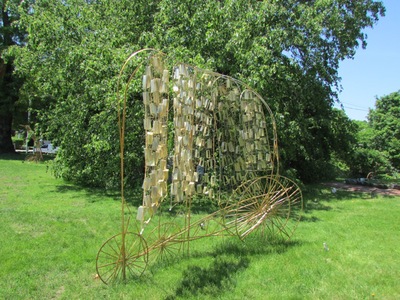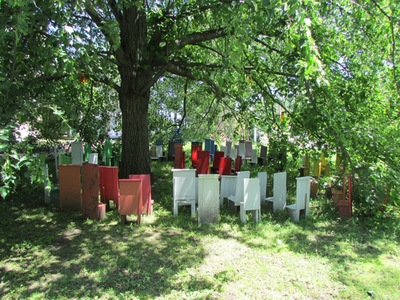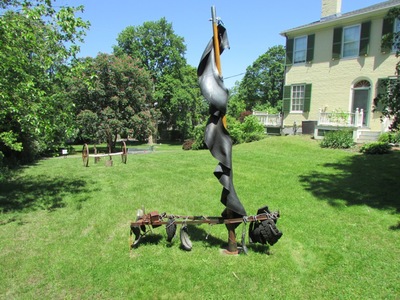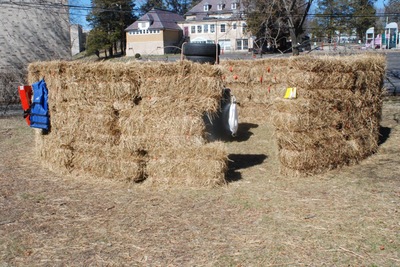Energy Necklace at the Jackson Homestead
Energy Necklace at the Jackson Homestead
Historic Newton, 527 Washington Street, Newton, MA
April 3–July 18, 2014
Susan Israel, curator
www.EnergyNecklace.com; www.historicnewton.org

Milan Klic; Acquisitions of Light, aluminum alloy, resin, steel, 9’ x 12’ x 4’; photo credit, Susan Israel
The debut of Energy Necklace at the Jackson Homestead and Museum is also the debut of a public sculpture exhibition for the distinctive institution itself. Cindy Stone, Jackson Homestead museum director, explains: “Once a stop on the Underground Railway, the Jackson Homestead sought to stop the exploitation of people just as the Energy Necklace seeks to curtail exploitation of the earth. They seemed like complementary themes.” The Energy Necklace sustainability-focused project, curated by LEED certified architect Susan Israel, its founder and principal, plans to continue to develop beyond the community of Newton, with exhibitions along the series of parks in Boston that form the Emerald Necklace designed by Frederick Law Olmsted. This well-known, prolific New England landscape architect (1822-1903) is, of course, considered a visionary in environmental stewardship.

Gail Bos; Children’s Chairs, painted wood, 3’ x 20’ x 20’; photo credit, Susan Israel
Visitors in Newton are greeted by Milan Klic’s magical Acquisitions of Light, a sculptural assemblage made of resin, wire, and metal that acts as a “light catcher.” It is a delicate yet resilient structure that sways with the wind, a bit like a sail made of wire with roughly rectangular structures. The artist speaks of the necessity of “acquiring” the light in the present for future use, obliquely referring to a conservation of energy. Children’s Chairs, by Gail Bos, circles under the umbrella of an ancient Linden tree. It is an immediately engaging work, its combination of color and form very successful. Though diminutive in size, all under 3’ in height, the chairs are sturdy enough for an adult to sit on. Bos raises the question of whether we are responsible custodians for the children in our care. Some of the chairs represent children seriously wounded by guns each day in the USA. They [the surrogate children] are temporarily sheltered by the great tree, but when they look towards their future, outside the circle of safety, what might they encounter?

Susan Israel, Peter Lipsitt; Tempest Tossed, mixed media, 10’ x 8’ x 2’; photo credit, Susan Israel
Peter Lipsitt and curator Susan Israel collaborated on the totemic Tempest Tossed. Here, slices of gigantic rubber inner tubes, sensitively textured almost like a tattoo, furl gracefully around a mast. Bound by woven rope, heavy pieces of repurposed tires, dense and black, hang alongside. The artists write that Tempest Tossed is meant to recall the trade voyages that were part of the slave trade. First bound and transported on these ships, some slaves broke free and escaped through places like the Jackson Homestead as a stop on the Underground Railroad. Reusing familiar materials suggests resilience, regeneration and reclamation.

Mary Dewart, Rescue, haybales, life preservers, life safety rings, fossil fuel-based object, rope, 5’ x 12’ x 12’; photo credit, Mary Dewart
Mary Dewart’s Rescue is a circular haven of still-fragrant hay bales that give one a sense of peace and the experience of bucolic nature, but its tower of 55 gallon barrels, safety rings, and piled tires at the center sounds an ominous note, as do fluttering orange construction flags. Life jackets, installed around the exterior with names like “Sea-Fit” and “Safegard,” seem to offer salvation. Dewart asks a poignant and pointed question: “Demands of fossil fuels are changing our climate and planet at an unprecedented rate. Will humans take action and make changes to reduce our use, adapt to renewable energy sources and rescue life as we know it? Are we bystanders or lifeguards?”
Taken together, the common theme in the exhibition’s range of sculptural expression is the challenge of sustainability and preservation of the planet we walk upon. Not surprisingly, then, the use of found and adapted materials throughout the exhibition is varied. The range encompasses Forest Falls by Linda Hoffman and Margot Stage, using knotted ropes, Jeanne Williamson’s Fence Holes Bandage of monoprinted construction patterns, Linda Hoffman and Gabrielle White’s Procession of antiquated wagon wheels, Margo Stage’s Umbilical cord woven of her deceased mother’s clothing and her own, Peter Kronberg’s terracotta Jake, and John Powell’s Solar Shards, made of solar-powered Plexiglas.
Each of the works installed at the Homestead provides a kind of oasis within the stream of city traffic that continually moves past the site. Additionally, happily, an insistent bird accompanied me on my journey through the temporary urban sculpture park. Its natural song was particularly meaningful, a positive harbinger in the context of this thematic sculpture exhibition. Just beyond the Homestead, children’s schoolyard play carried in the air, further signaling renewal of life and hope for a successful communal future on this planet.
—B. Amore
